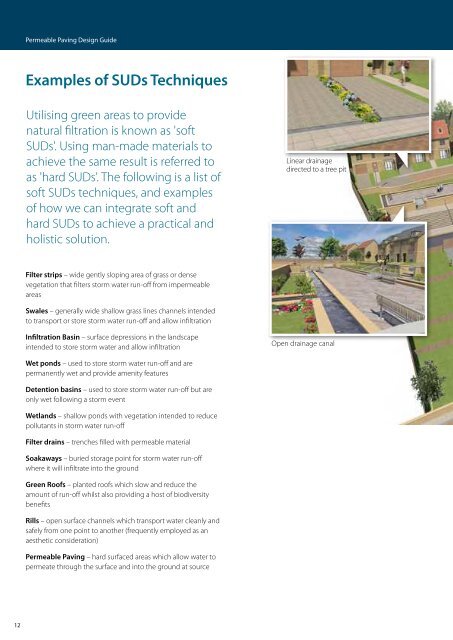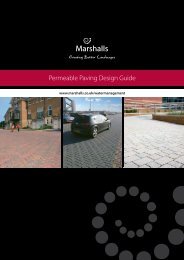Create successful ePaper yourself
Turn your PDF publications into a flip-book with our unique Google optimized e-Paper software.
12<br />
<strong>Permeable</strong> <strong>Paving</strong> <strong>Design</strong> <strong>Guide</strong><br />
Examples of SUDs Techniques<br />
Utilising green areas to provide<br />
natural filtration is known as 'soft<br />
SUDs'. Using man-made materials to<br />
achieve the same result is referred to<br />
as 'hard SUDs'. The following is a list of<br />
soft SUDs techniques, and examples<br />
of how we can integrate soft and<br />
hard SUDs to achieve a practical and<br />
holistic solution.<br />
Filter strips – wide gently sloping area of grass or dense<br />
vegetation that filters storm water run-off from impermeable<br />
areas<br />
Swales – generally wide shallow grass lines channels intended<br />
to transport or store storm water run-off and allow infiltration<br />
Infiltration Basin – surface depressions in the landscape<br />
intended to store storm water and allow infiltration<br />
Wet ponds – used to store storm water run-off and are<br />
permanently wet and provide amenity features<br />
Detention basins – used to store storm water run-off but are<br />
only wet following a storm event<br />
Wetlands – shallow ponds with vegetation intended to reduce<br />
pollutants in storm water run-off<br />
Filter drains – trenches filled with permeable material<br />
Soakaways – buried storage point for storm water run-off<br />
where it will infiltrate into the ground<br />
Green Roofs – planted roofs which slow and reduce the<br />
amount of run-off whilst also providing a host of biodiversity<br />
benefits<br />
Rills – open surface channels which transport water cleanly and<br />
safely from one point to another (frequently employed as an<br />
aesthetic consideration)<br />
<strong>Permeable</strong> <strong>Paving</strong> – hard surfaced areas which allow water to<br />
permeate through the surface and into the ground at source<br />
Linear drainage<br />
directed to a tree pit<br />
Open drainage canal<br />
<strong>Permeable</strong> paving<br />
Adopting wider use of these features will<br />
make a marked difference to our landscapes,<br />
improving habitats for wildlife and flora<br />
and reducing the risk of flooding. However,<br />
we cannot ignore the growing need for<br />
hardstanding. People need to drive and park<br />
vehicles, ride bikes, and push prams and<br />
wheelchairs comfortably and easily. We all<br />
enjoy aesthetically appealing public spaces<br />
which retain their clean, sleek looks with the<br />
www.marshalls.co.uk/watermanagement<br />
Linear channel into<br />
an attenuation pond<br />
Marshalls Beany combined kerb and<br />
drainage into a swale<br />
minimum of maintenance. even taking into<br />
account the growing awareness of green<br />
issues, we have to accept that we all want<br />
to go about our modern lives with the least<br />
amount of mess and difficulty; hard standing<br />
is here to stay.<br />
So, the question is: how do we satisfy these<br />
modern requirements whilst mitigating the<br />
effects of water stress?<br />
13



